University Business Communication Annotated Bibliography Report
VerifiedAdded on 2022/08/12
|11
|2572
|11
Annotated Bibliography
AI Summary
This annotated bibliography analyzes ten articles focused on business communication, particularly the use of social media platforms like Facebook for strategic marketing. The report evaluates the credibility and effectiveness of these sources, examining their contributions to understanding brand equity, impression management, and the development of comprehensive communication strategies. The articles cover topics such as the impact of Facebook on brand communication, impression management strategies in company-consumer interactions, the use of Facebook by fashion retailers, the benefits of social media marketing for small and medium-sized enterprises (SMEs), the role of social media in the wine industry, issues of professionalism in educational settings, the effectiveness of social media as a marketing tool, the use of social media in marketing research, the importance of Facebook as an online social networking tool, and the use of Facebook as a destination marketing tool. The conclusion summarizes the findings, highlighting both the advantages and limitations of using social media for business communication.
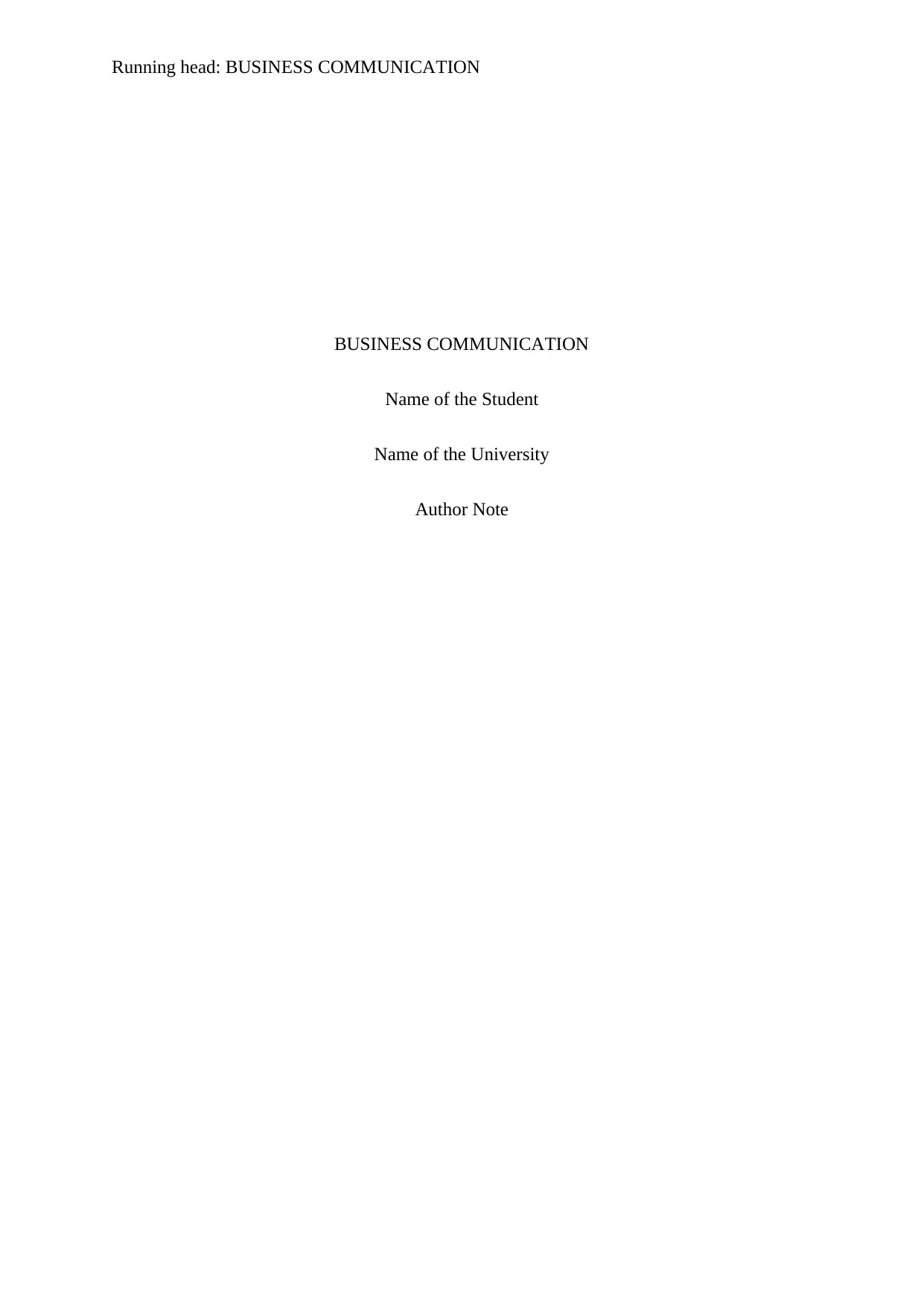
Running head: BUSINESS COMMUNICATION
BUSINESS COMMUNICATION
Name of the Student
Name of the University
Author Note
BUSINESS COMMUNICATION
Name of the Student
Name of the University
Author Note
Paraphrase This Document
Need a fresh take? Get an instant paraphrase of this document with our AI Paraphraser
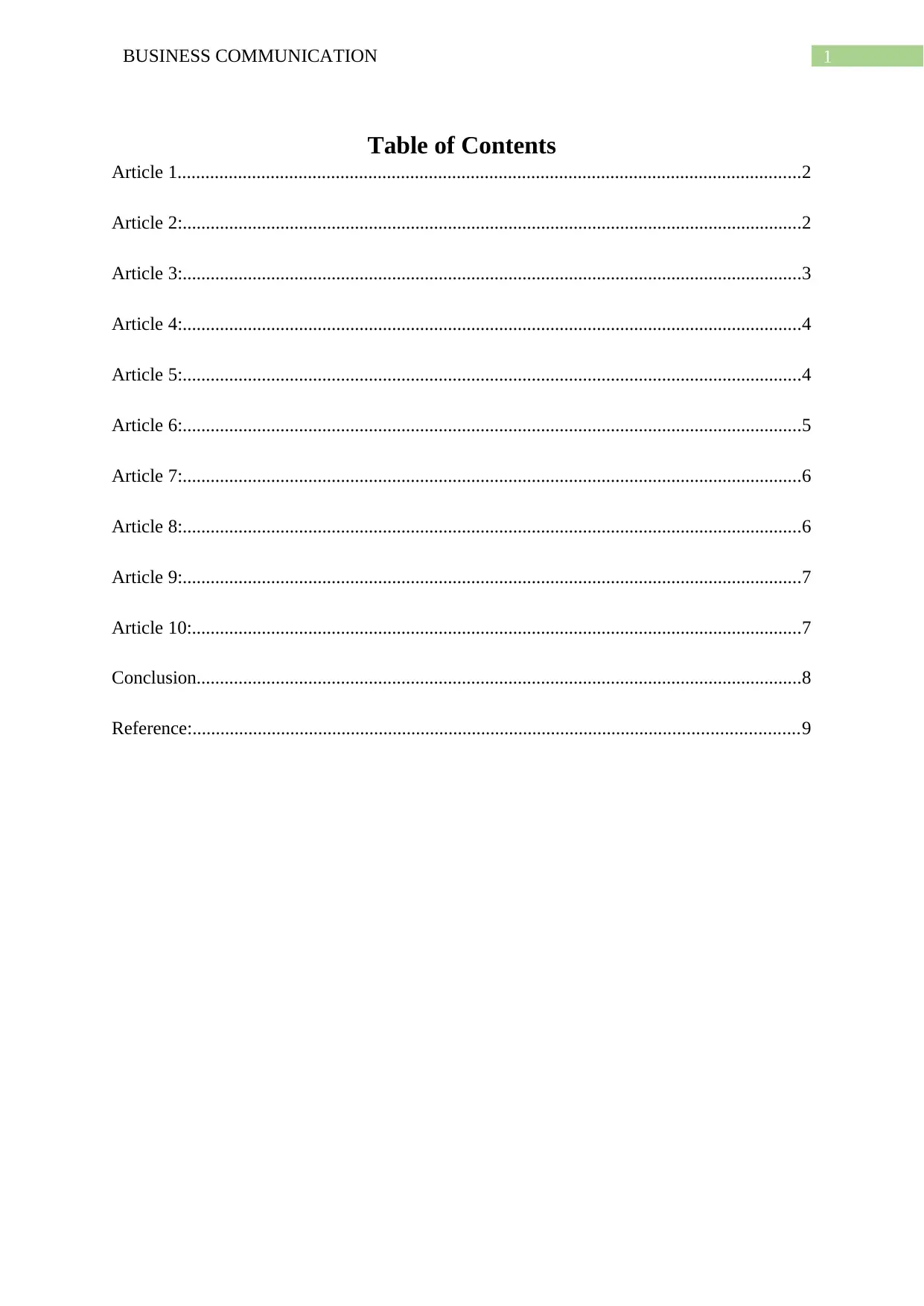
1BUSINESS COMMUNICATION
Table of Contents
Article 1......................................................................................................................................2
Article 2:.....................................................................................................................................2
Article 3:.....................................................................................................................................3
Article 4:.....................................................................................................................................4
Article 5:.....................................................................................................................................4
Article 6:.....................................................................................................................................5
Article 7:.....................................................................................................................................6
Article 8:.....................................................................................................................................6
Article 9:.....................................................................................................................................7
Article 10:...................................................................................................................................7
Conclusion..................................................................................................................................8
Reference:..................................................................................................................................9
Table of Contents
Article 1......................................................................................................................................2
Article 2:.....................................................................................................................................2
Article 3:.....................................................................................................................................3
Article 4:.....................................................................................................................................4
Article 5:.....................................................................................................................................4
Article 6:.....................................................................................................................................5
Article 7:.....................................................................................................................................6
Article 8:.....................................................................................................................................6
Article 9:.....................................................................................................................................7
Article 10:...................................................................................................................................7
Conclusion..................................................................................................................................8
Reference:..................................................................................................................................9
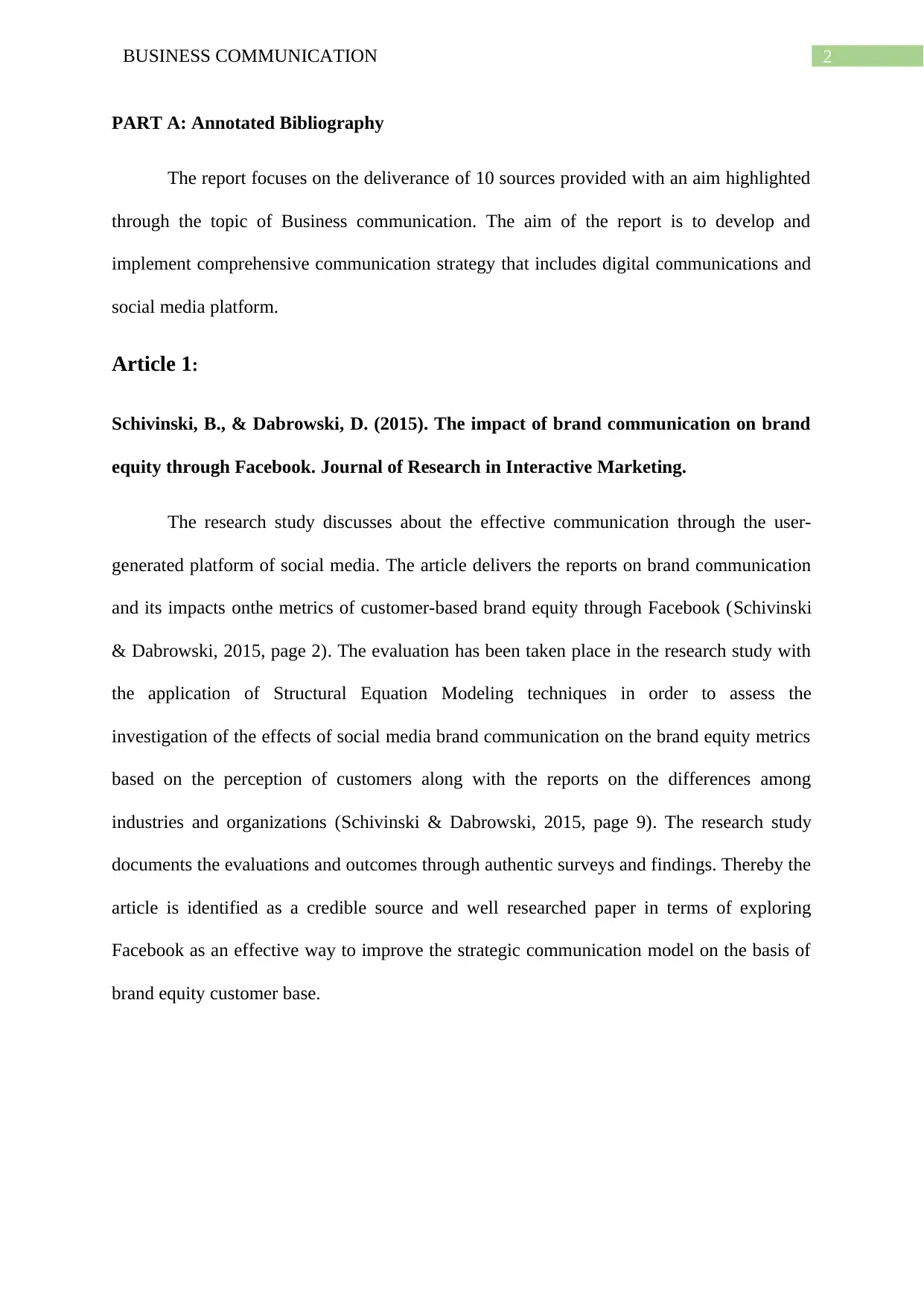
2BUSINESS COMMUNICATION
PART A: Annotated Bibliography
The report focuses on the deliverance of 10 sources provided with an aim highlighted
through the topic of Business communication. The aim of the report is to develop and
implement comprehensive communication strategy that includes digital communications and
social media platform.
Article 1:
Schivinski, B., & Dabrowski, D. (2015). The impact of brand communication on brand
equity through Facebook. Journal of Research in Interactive Marketing.
The research study discusses about the effective communication through the user-
generated platform of social media. The article delivers the reports on brand communication
and its impacts onthe metrics of customer-based brand equity through Facebook (Schivinski
& Dabrowski, 2015, page 2). The evaluation has been taken place in the research study with
the application of Structural Equation Modeling techniques in order to assess the
investigation of the effects of social media brand communication on the brand equity metrics
based on the perception of customers along with the reports on the differences among
industries and organizations (Schivinski & Dabrowski, 2015, page 9). The research study
documents the evaluations and outcomes through authentic surveys and findings. Thereby the
article is identified as a credible source and well researched paper in terms of exploring
Facebook as an effective way to improve the strategic communication model on the basis of
brand equity customer base.
PART A: Annotated Bibliography
The report focuses on the deliverance of 10 sources provided with an aim highlighted
through the topic of Business communication. The aim of the report is to develop and
implement comprehensive communication strategy that includes digital communications and
social media platform.
Article 1:
Schivinski, B., & Dabrowski, D. (2015). The impact of brand communication on brand
equity through Facebook. Journal of Research in Interactive Marketing.
The research study discusses about the effective communication through the user-
generated platform of social media. The article delivers the reports on brand communication
and its impacts onthe metrics of customer-based brand equity through Facebook (Schivinski
& Dabrowski, 2015, page 2). The evaluation has been taken place in the research study with
the application of Structural Equation Modeling techniques in order to assess the
investigation of the effects of social media brand communication on the brand equity metrics
based on the perception of customers along with the reports on the differences among
industries and organizations (Schivinski & Dabrowski, 2015, page 9). The research study
documents the evaluations and outcomes through authentic surveys and findings. Thereby the
article is identified as a credible source and well researched paper in terms of exploring
Facebook as an effective way to improve the strategic communication model on the basis of
brand equity customer base.
⊘ This is a preview!⊘
Do you want full access?
Subscribe today to unlock all pages.

Trusted by 1+ million students worldwide
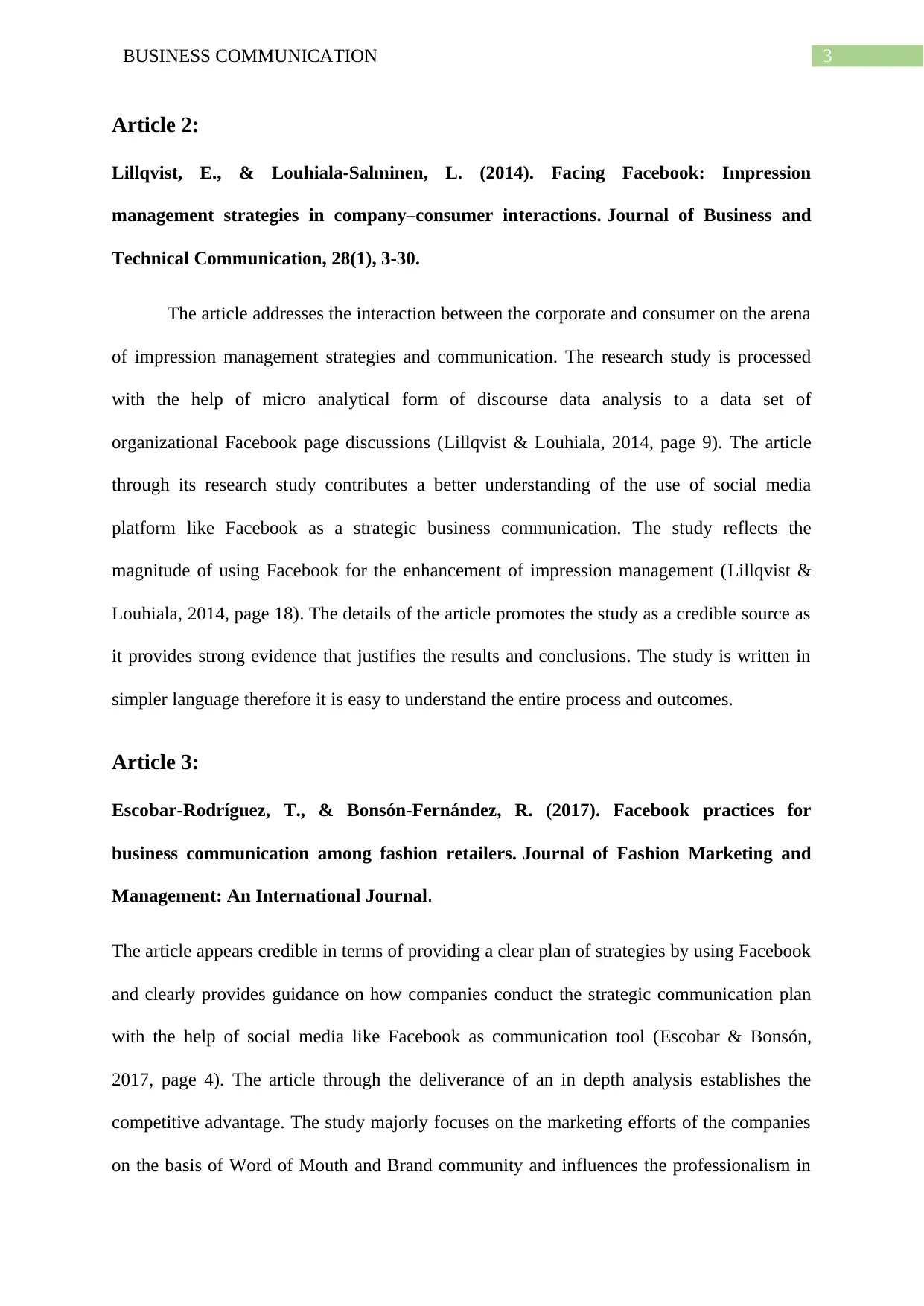
3BUSINESS COMMUNICATION
Article 2:
Lillqvist, E., & Louhiala-Salminen, L. (2014). Facing Facebook: Impression
management strategies in company–consumer interactions. Journal of Business and
Technical Communication, 28(1), 3-30.
The article addresses the interaction between the corporate and consumer on the arena
of impression management strategies and communication. The research study is processed
with the help of micro analytical form of discourse data analysis to a data set of
organizational Facebook page discussions (Lillqvist & Louhiala, 2014, page 9). The article
through its research study contributes a better understanding of the use of social media
platform like Facebook as a strategic business communication. The study reflects the
magnitude of using Facebook for the enhancement of impression management (Lillqvist &
Louhiala, 2014, page 18). The details of the article promotes the study as a credible source as
it provides strong evidence that justifies the results and conclusions. The study is written in
simpler language therefore it is easy to understand the entire process and outcomes.
Article 3:
Escobar-Rodríguez, T., & Bonsón-Fernández, R. (2017). Facebook practices for
business communication among fashion retailers. Journal of Fashion Marketing and
Management: An International Journal.
The article appears credible in terms of providing a clear plan of strategies by using Facebook
and clearly provides guidance on how companies conduct the strategic communication plan
with the help of social media like Facebook as communication tool (Escobar & Bonsón,
2017, page 4). The article through the deliverance of an in depth analysis establishes the
competitive advantage. The study majorly focuses on the marketing efforts of the companies
on the basis of Word of Mouth and Brand community and influences the professionalism in
Article 2:
Lillqvist, E., & Louhiala-Salminen, L. (2014). Facing Facebook: Impression
management strategies in company–consumer interactions. Journal of Business and
Technical Communication, 28(1), 3-30.
The article addresses the interaction between the corporate and consumer on the arena
of impression management strategies and communication. The research study is processed
with the help of micro analytical form of discourse data analysis to a data set of
organizational Facebook page discussions (Lillqvist & Louhiala, 2014, page 9). The article
through its research study contributes a better understanding of the use of social media
platform like Facebook as a strategic business communication. The study reflects the
magnitude of using Facebook for the enhancement of impression management (Lillqvist &
Louhiala, 2014, page 18). The details of the article promotes the study as a credible source as
it provides strong evidence that justifies the results and conclusions. The study is written in
simpler language therefore it is easy to understand the entire process and outcomes.
Article 3:
Escobar-Rodríguez, T., & Bonsón-Fernández, R. (2017). Facebook practices for
business communication among fashion retailers. Journal of Fashion Marketing and
Management: An International Journal.
The article appears credible in terms of providing a clear plan of strategies by using Facebook
and clearly provides guidance on how companies conduct the strategic communication plan
with the help of social media like Facebook as communication tool (Escobar & Bonsón,
2017, page 4). The article through the deliverance of an in depth analysis establishes the
competitive advantage. The study majorly focuses on the marketing efforts of the companies
on the basis of Word of Mouth and Brand community and influences the professionalism in
Paraphrase This Document
Need a fresh take? Get an instant paraphrase of this document with our AI Paraphraser
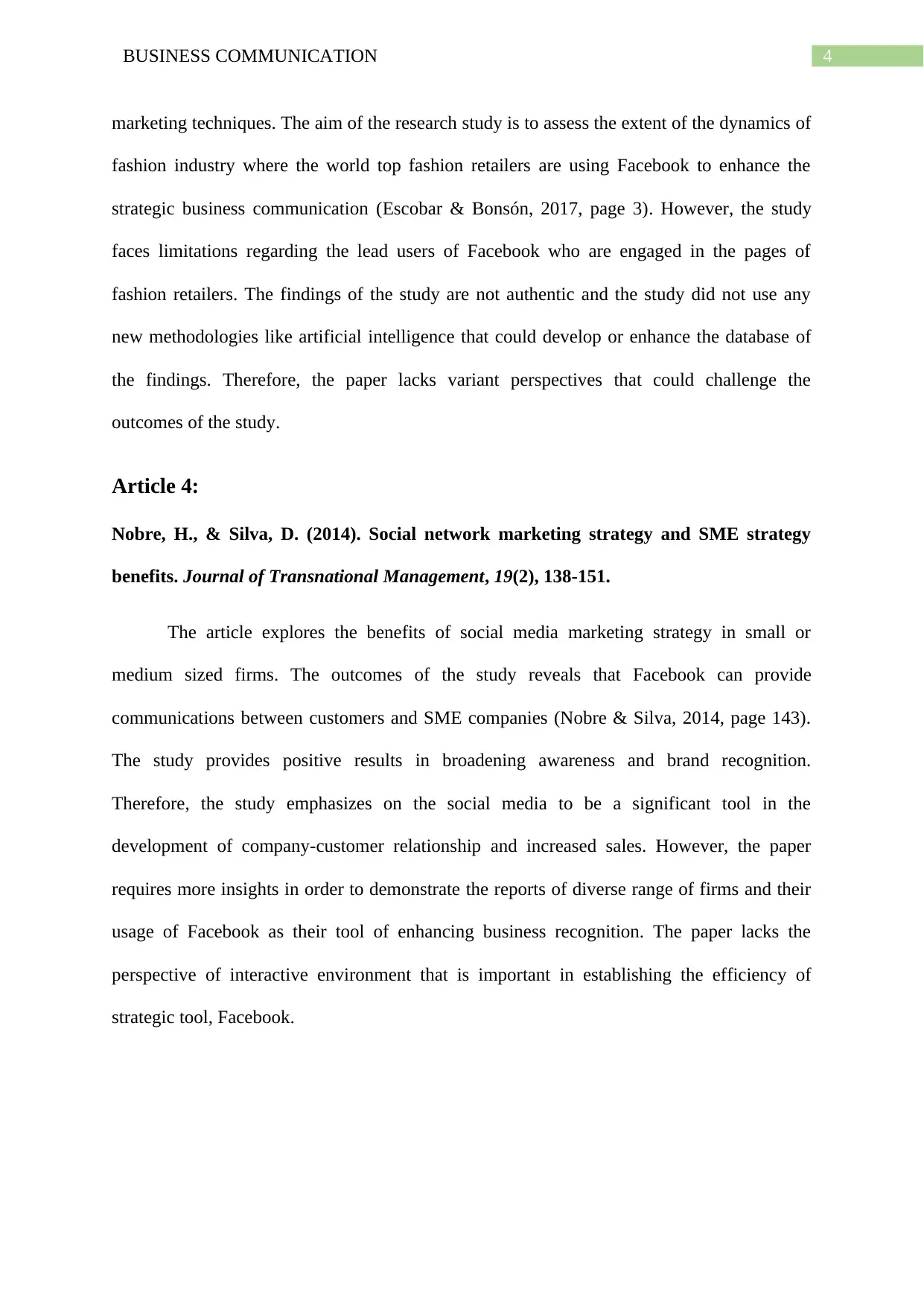
4BUSINESS COMMUNICATION
marketing techniques. The aim of the research study is to assess the extent of the dynamics of
fashion industry where the world top fashion retailers are using Facebook to enhance the
strategic business communication (Escobar & Bonsón, 2017, page 3). However, the study
faces limitations regarding the lead users of Facebook who are engaged in the pages of
fashion retailers. The findings of the study are not authentic and the study did not use any
new methodologies like artificial intelligence that could develop or enhance the database of
the findings. Therefore, the paper lacks variant perspectives that could challenge the
outcomes of the study.
Article 4:
Nobre, H., & Silva, D. (2014). Social network marketing strategy and SME strategy
benefits. Journal of Transnational Management, 19(2), 138-151.
The article explores the benefits of social media marketing strategy in small or
medium sized firms. The outcomes of the study reveals that Facebook can provide
communications between customers and SME companies (Nobre & Silva, 2014, page 143).
The study provides positive results in broadening awareness and brand recognition.
Therefore, the study emphasizes on the social media to be a significant tool in the
development of company-customer relationship and increased sales. However, the paper
requires more insights in order to demonstrate the reports of diverse range of firms and their
usage of Facebook as their tool of enhancing business recognition. The paper lacks the
perspective of interactive environment that is important in establishing the efficiency of
strategic tool, Facebook.
marketing techniques. The aim of the research study is to assess the extent of the dynamics of
fashion industry where the world top fashion retailers are using Facebook to enhance the
strategic business communication (Escobar & Bonsón, 2017, page 3). However, the study
faces limitations regarding the lead users of Facebook who are engaged in the pages of
fashion retailers. The findings of the study are not authentic and the study did not use any
new methodologies like artificial intelligence that could develop or enhance the database of
the findings. Therefore, the paper lacks variant perspectives that could challenge the
outcomes of the study.
Article 4:
Nobre, H., & Silva, D. (2014). Social network marketing strategy and SME strategy
benefits. Journal of Transnational Management, 19(2), 138-151.
The article explores the benefits of social media marketing strategy in small or
medium sized firms. The outcomes of the study reveals that Facebook can provide
communications between customers and SME companies (Nobre & Silva, 2014, page 143).
The study provides positive results in broadening awareness and brand recognition.
Therefore, the study emphasizes on the social media to be a significant tool in the
development of company-customer relationship and increased sales. However, the paper
requires more insights in order to demonstrate the reports of diverse range of firms and their
usage of Facebook as their tool of enhancing business recognition. The paper lacks the
perspective of interactive environment that is important in establishing the efficiency of
strategic tool, Facebook.
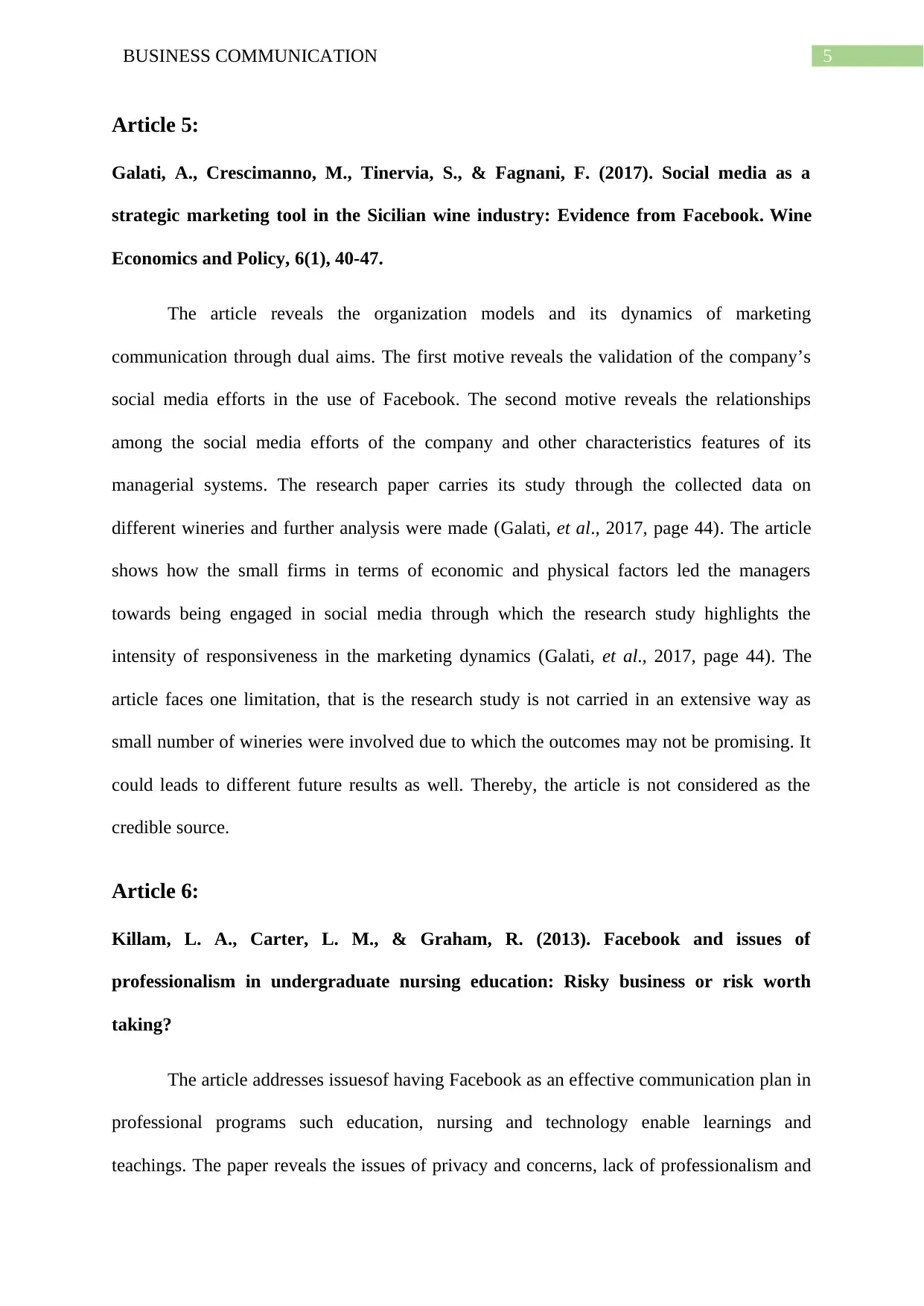
5BUSINESS COMMUNICATION
Article 5:
Galati, A., Crescimanno, M., Tinervia, S., & Fagnani, F. (2017). Social media as a
strategic marketing tool in the Sicilian wine industry: Evidence from Facebook. Wine
Economics and Policy, 6(1), 40-47.
The article reveals the organization models and its dynamics of marketing
communication through dual aims. The first motive reveals the validation of the company’s
social media efforts in the use of Facebook. The second motive reveals the relationships
among the social media efforts of the company and other characteristics features of its
managerial systems. The research paper carries its study through the collected data on
different wineries and further analysis were made (Galati, et al., 2017, page 44). The article
shows how the small firms in terms of economic and physical factors led the managers
towards being engaged in social media through which the research study highlights the
intensity of responsiveness in the marketing dynamics (Galati, et al., 2017, page 44). The
article faces one limitation, that is the research study is not carried in an extensive way as
small number of wineries were involved due to which the outcomes may not be promising. It
could leads to different future results as well. Thereby, the article is not considered as the
credible source.
Article 6:
Killam, L. A., Carter, L. M., & Graham, R. (2013). Facebook and issues of
professionalism in undergraduate nursing education: Risky business or risk worth
taking?
The article addresses issuesof having Facebook as an effective communication plan in
professional programs such education, nursing and technology enable learnings and
teachings. The paper reveals the issues of privacy and concerns, lack of professionalism and
Article 5:
Galati, A., Crescimanno, M., Tinervia, S., & Fagnani, F. (2017). Social media as a
strategic marketing tool in the Sicilian wine industry: Evidence from Facebook. Wine
Economics and Policy, 6(1), 40-47.
The article reveals the organization models and its dynamics of marketing
communication through dual aims. The first motive reveals the validation of the company’s
social media efforts in the use of Facebook. The second motive reveals the relationships
among the social media efforts of the company and other characteristics features of its
managerial systems. The research paper carries its study through the collected data on
different wineries and further analysis were made (Galati, et al., 2017, page 44). The article
shows how the small firms in terms of economic and physical factors led the managers
towards being engaged in social media through which the research study highlights the
intensity of responsiveness in the marketing dynamics (Galati, et al., 2017, page 44). The
article faces one limitation, that is the research study is not carried in an extensive way as
small number of wineries were involved due to which the outcomes may not be promising. It
could leads to different future results as well. Thereby, the article is not considered as the
credible source.
Article 6:
Killam, L. A., Carter, L. M., & Graham, R. (2013). Facebook and issues of
professionalism in undergraduate nursing education: Risky business or risk worth
taking?
The article addresses issuesof having Facebook as an effective communication plan in
professional programs such education, nursing and technology enable learnings and
teachings. The paper reveals the issues of privacy and concerns, lack of professionalism and
⊘ This is a preview!⊘
Do you want full access?
Subscribe today to unlock all pages.

Trusted by 1+ million students worldwide
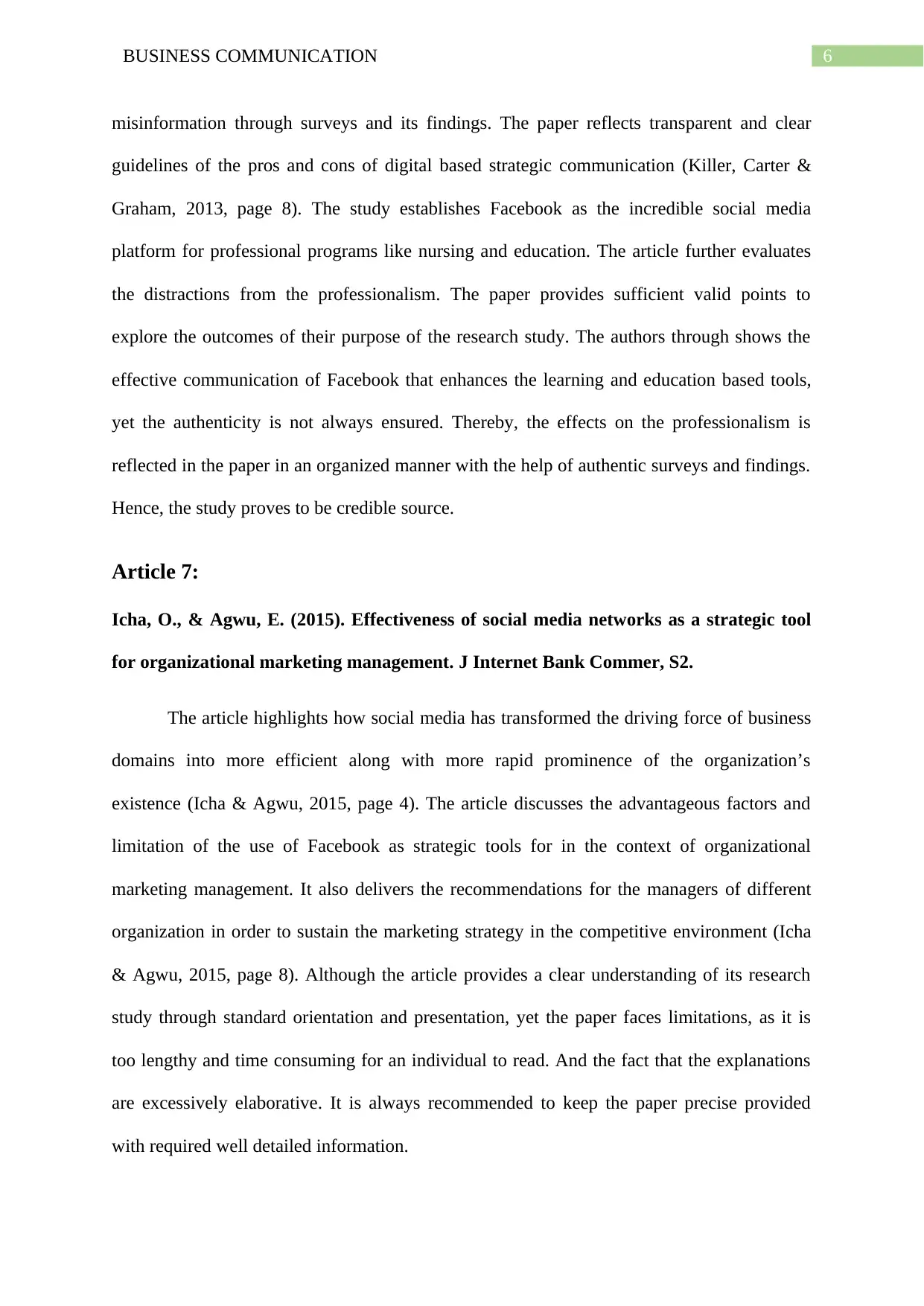
6BUSINESS COMMUNICATION
misinformation through surveys and its findings. The paper reflects transparent and clear
guidelines of the pros and cons of digital based strategic communication (Killer, Carter &
Graham, 2013, page 8). The study establishes Facebook as the incredible social media
platform for professional programs like nursing and education. The article further evaluates
the distractions from the professionalism. The paper provides sufficient valid points to
explore the outcomes of their purpose of the research study. The authors through shows the
effective communication of Facebook that enhances the learning and education based tools,
yet the authenticity is not always ensured. Thereby, the effects on the professionalism is
reflected in the paper in an organized manner with the help of authentic surveys and findings.
Hence, the study proves to be credible source.
Article 7:
Icha, O., & Agwu, E. (2015). Effectiveness of social media networks as a strategic tool
for organizational marketing management. J Internet Bank Commer, S2.
The article highlights how social media has transformed the driving force of business
domains into more efficient along with more rapid prominence of the organization’s
existence (Icha & Agwu, 2015, page 4). The article discusses the advantageous factors and
limitation of the use of Facebook as strategic tools for in the context of organizational
marketing management. It also delivers the recommendations for the managers of different
organization in order to sustain the marketing strategy in the competitive environment (Icha
& Agwu, 2015, page 8). Although the article provides a clear understanding of its research
study through standard orientation and presentation, yet the paper faces limitations, as it is
too lengthy and time consuming for an individual to read. And the fact that the explanations
are excessively elaborative. It is always recommended to keep the paper precise provided
with required well detailed information.
misinformation through surveys and its findings. The paper reflects transparent and clear
guidelines of the pros and cons of digital based strategic communication (Killer, Carter &
Graham, 2013, page 8). The study establishes Facebook as the incredible social media
platform for professional programs like nursing and education. The article further evaluates
the distractions from the professionalism. The paper provides sufficient valid points to
explore the outcomes of their purpose of the research study. The authors through shows the
effective communication of Facebook that enhances the learning and education based tools,
yet the authenticity is not always ensured. Thereby, the effects on the professionalism is
reflected in the paper in an organized manner with the help of authentic surveys and findings.
Hence, the study proves to be credible source.
Article 7:
Icha, O., & Agwu, E. (2015). Effectiveness of social media networks as a strategic tool
for organizational marketing management. J Internet Bank Commer, S2.
The article highlights how social media has transformed the driving force of business
domains into more efficient along with more rapid prominence of the organization’s
existence (Icha & Agwu, 2015, page 4). The article discusses the advantageous factors and
limitation of the use of Facebook as strategic tools for in the context of organizational
marketing management. It also delivers the recommendations for the managers of different
organization in order to sustain the marketing strategy in the competitive environment (Icha
& Agwu, 2015, page 8). Although the article provides a clear understanding of its research
study through standard orientation and presentation, yet the paper faces limitations, as it is
too lengthy and time consuming for an individual to read. And the fact that the explanations
are excessively elaborative. It is always recommended to keep the paper precise provided
with required well detailed information.
Paraphrase This Document
Need a fresh take? Get an instant paraphrase of this document with our AI Paraphraser
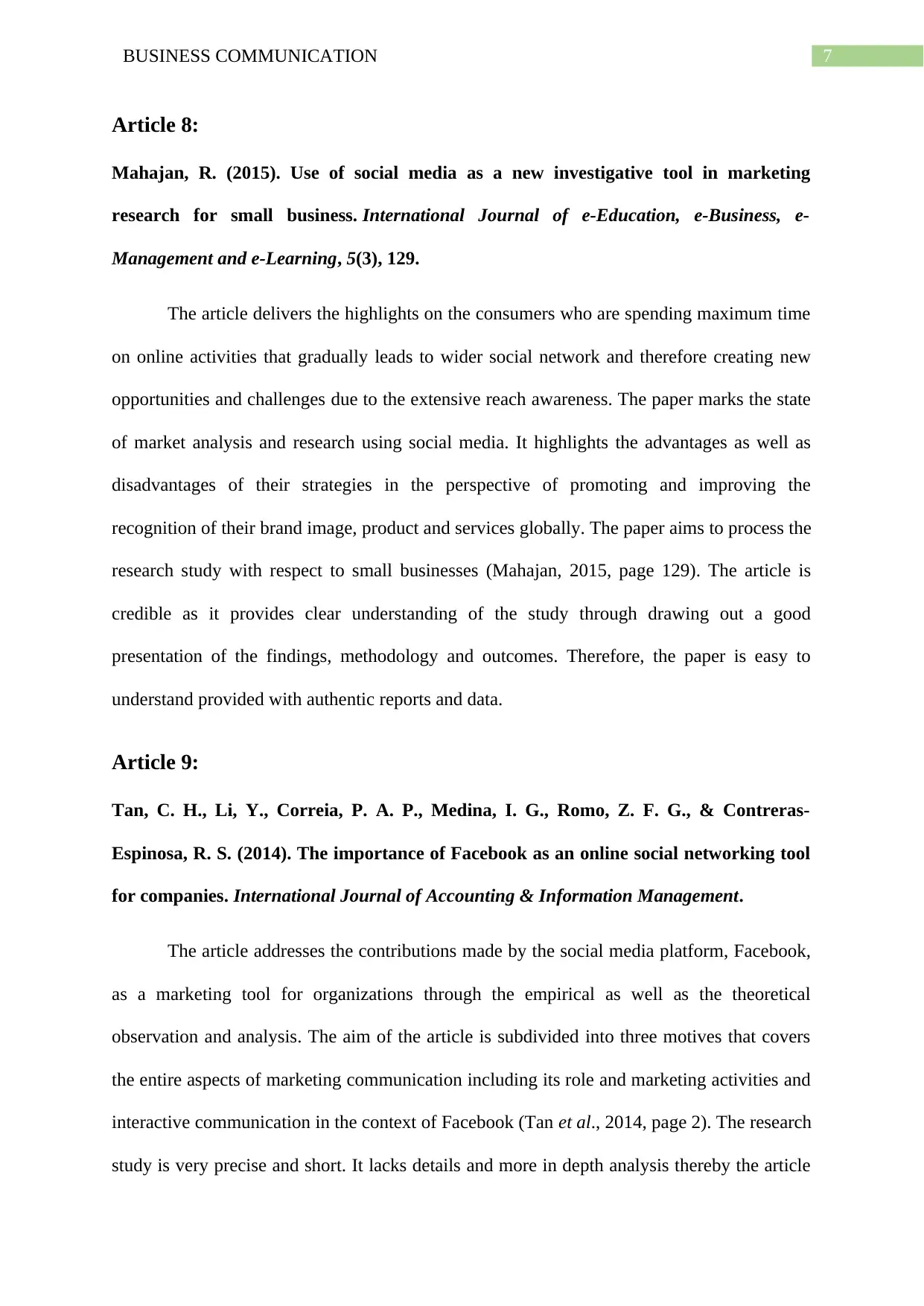
7BUSINESS COMMUNICATION
Article 8:
Mahajan, R. (2015). Use of social media as a new investigative tool in marketing
research for small business. International Journal of e-Education, e-Business, e-
Management and e-Learning, 5(3), 129.
The article delivers the highlights on the consumers who are spending maximum time
on online activities that gradually leads to wider social network and therefore creating new
opportunities and challenges due to the extensive reach awareness. The paper marks the state
of market analysis and research using social media. It highlights the advantages as well as
disadvantages of their strategies in the perspective of promoting and improving the
recognition of their brand image, product and services globally. The paper aims to process the
research study with respect to small businesses (Mahajan, 2015, page 129). The article is
credible as it provides clear understanding of the study through drawing out a good
presentation of the findings, methodology and outcomes. Therefore, the paper is easy to
understand provided with authentic reports and data.
Article 9:
Tan, C. H., Li, Y., Correia, P. A. P., Medina, I. G., Romo, Z. F. G., & Contreras-
Espinosa, R. S. (2014). The importance of Facebook as an online social networking tool
for companies. International Journal of Accounting & Information Management.
The article addresses the contributions made by the social media platform, Facebook,
as a marketing tool for organizations through the empirical as well as the theoretical
observation and analysis. The aim of the article is subdivided into three motives that covers
the entire aspects of marketing communication including its role and marketing activities and
interactive communication in the context of Facebook (Tan et al., 2014, page 2). The research
study is very precise and short. It lacks details and more in depth analysis thereby the article
Article 8:
Mahajan, R. (2015). Use of social media as a new investigative tool in marketing
research for small business. International Journal of e-Education, e-Business, e-
Management and e-Learning, 5(3), 129.
The article delivers the highlights on the consumers who are spending maximum time
on online activities that gradually leads to wider social network and therefore creating new
opportunities and challenges due to the extensive reach awareness. The paper marks the state
of market analysis and research using social media. It highlights the advantages as well as
disadvantages of their strategies in the perspective of promoting and improving the
recognition of their brand image, product and services globally. The paper aims to process the
research study with respect to small businesses (Mahajan, 2015, page 129). The article is
credible as it provides clear understanding of the study through drawing out a good
presentation of the findings, methodology and outcomes. Therefore, the paper is easy to
understand provided with authentic reports and data.
Article 9:
Tan, C. H., Li, Y., Correia, P. A. P., Medina, I. G., Romo, Z. F. G., & Contreras-
Espinosa, R. S. (2014). The importance of Facebook as an online social networking tool
for companies. International Journal of Accounting & Information Management.
The article addresses the contributions made by the social media platform, Facebook,
as a marketing tool for organizations through the empirical as well as the theoretical
observation and analysis. The aim of the article is subdivided into three motives that covers
the entire aspects of marketing communication including its role and marketing activities and
interactive communication in the context of Facebook (Tan et al., 2014, page 2). The research
study is very precise and short. It lacks details and more in depth analysis thereby the article
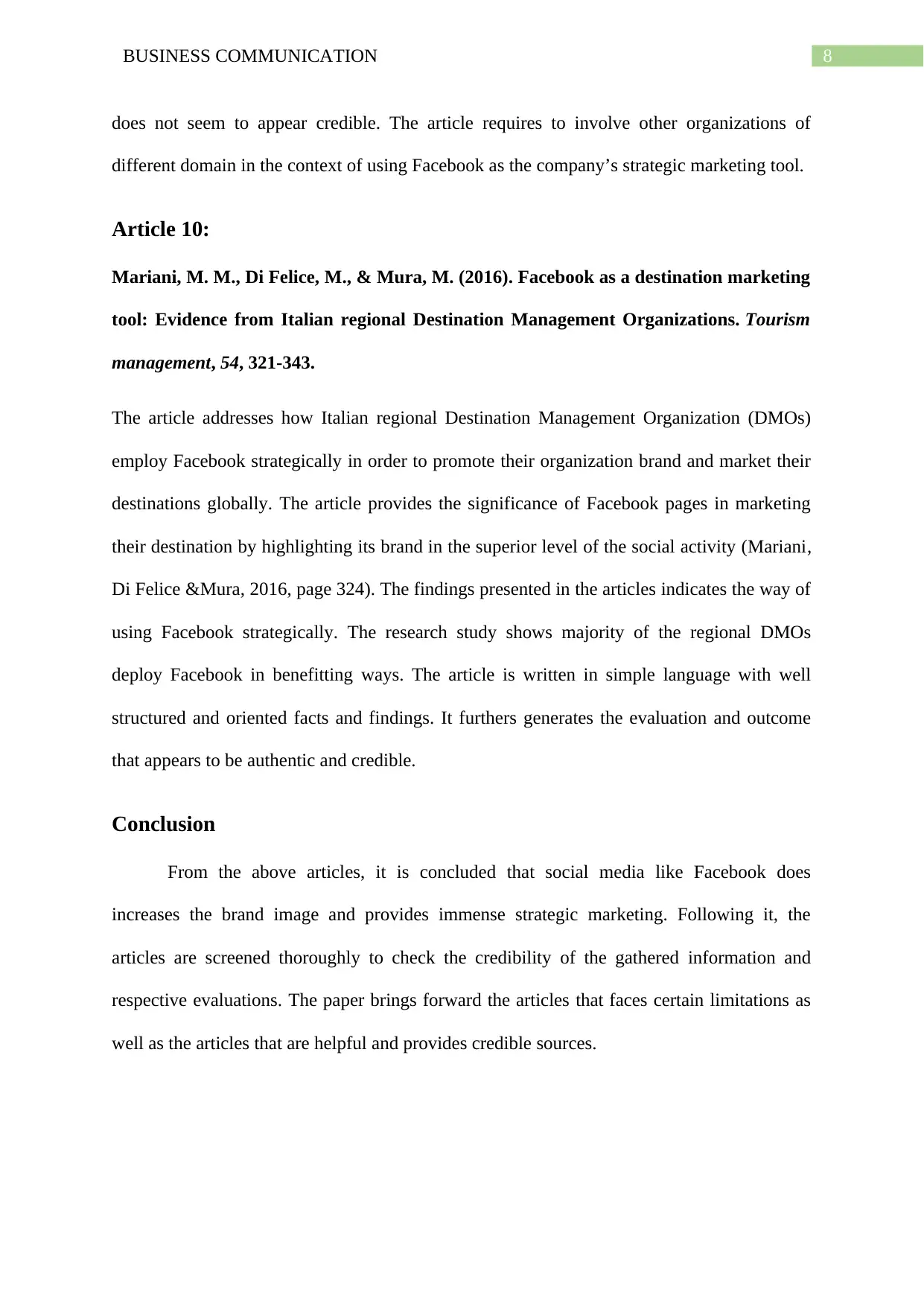
8BUSINESS COMMUNICATION
does not seem to appear credible. The article requires to involve other organizations of
different domain in the context of using Facebook as the company’s strategic marketing tool.
Article 10:
Mariani, M. M., Di Felice, M., & Mura, M. (2016). Facebook as a destination marketing
tool: Evidence from Italian regional Destination Management Organizations. Tourism
management, 54, 321-343.
The article addresses how Italian regional Destination Management Organization (DMOs)
employ Facebook strategically in order to promote their organization brand and market their
destinations globally. The article provides the significance of Facebook pages in marketing
their destination by highlighting its brand in the superior level of the social activity (Mariani,
Di Felice &Mura, 2016, page 324). The findings presented in the articles indicates the way of
using Facebook strategically. The research study shows majority of the regional DMOs
deploy Facebook in benefitting ways. The article is written in simple language with well
structured and oriented facts and findings. It furthers generates the evaluation and outcome
that appears to be authentic and credible.
Conclusion
From the above articles, it is concluded that social media like Facebook does
increases the brand image and provides immense strategic marketing. Following it, the
articles are screened thoroughly to check the credibility of the gathered information and
respective evaluations. The paper brings forward the articles that faces certain limitations as
well as the articles that are helpful and provides credible sources.
does not seem to appear credible. The article requires to involve other organizations of
different domain in the context of using Facebook as the company’s strategic marketing tool.
Article 10:
Mariani, M. M., Di Felice, M., & Mura, M. (2016). Facebook as a destination marketing
tool: Evidence from Italian regional Destination Management Organizations. Tourism
management, 54, 321-343.
The article addresses how Italian regional Destination Management Organization (DMOs)
employ Facebook strategically in order to promote their organization brand and market their
destinations globally. The article provides the significance of Facebook pages in marketing
their destination by highlighting its brand in the superior level of the social activity (Mariani,
Di Felice &Mura, 2016, page 324). The findings presented in the articles indicates the way of
using Facebook strategically. The research study shows majority of the regional DMOs
deploy Facebook in benefitting ways. The article is written in simple language with well
structured and oriented facts and findings. It furthers generates the evaluation and outcome
that appears to be authentic and credible.
Conclusion
From the above articles, it is concluded that social media like Facebook does
increases the brand image and provides immense strategic marketing. Following it, the
articles are screened thoroughly to check the credibility of the gathered information and
respective evaluations. The paper brings forward the articles that faces certain limitations as
well as the articles that are helpful and provides credible sources.
⊘ This is a preview!⊘
Do you want full access?
Subscribe today to unlock all pages.

Trusted by 1+ million students worldwide
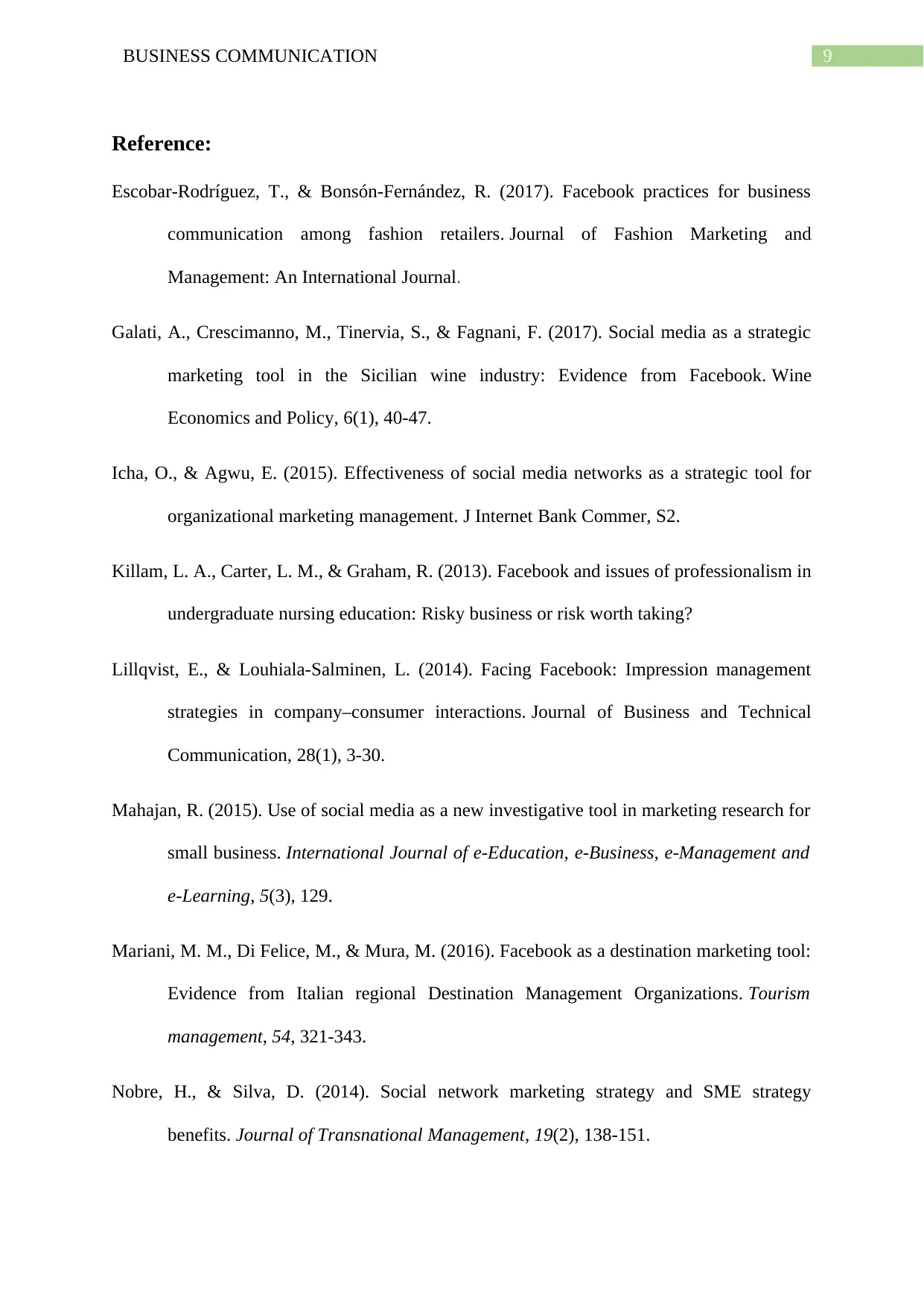
9BUSINESS COMMUNICATION
Reference:
Escobar-Rodríguez, T., & Bonsón-Fernández, R. (2017). Facebook practices for business
communication among fashion retailers. Journal of Fashion Marketing and
Management: An International Journal.
Galati, A., Crescimanno, M., Tinervia, S., & Fagnani, F. (2017). Social media as a strategic
marketing tool in the Sicilian wine industry: Evidence from Facebook. Wine
Economics and Policy, 6(1), 40-47.
Icha, O., & Agwu, E. (2015). Effectiveness of social media networks as a strategic tool for
organizational marketing management. J Internet Bank Commer, S2.
Killam, L. A., Carter, L. M., & Graham, R. (2013). Facebook and issues of professionalism in
undergraduate nursing education: Risky business or risk worth taking?
Lillqvist, E., & Louhiala-Salminen, L. (2014). Facing Facebook: Impression management
strategies in company–consumer interactions. Journal of Business and Technical
Communication, 28(1), 3-30.
Mahajan, R. (2015). Use of social media as a new investigative tool in marketing research for
small business. International Journal of e-Education, e-Business, e-Management and
e-Learning, 5(3), 129.
Mariani, M. M., Di Felice, M., & Mura, M. (2016). Facebook as a destination marketing tool:
Evidence from Italian regional Destination Management Organizations. Tourism
management, 54, 321-343.
Nobre, H., & Silva, D. (2014). Social network marketing strategy and SME strategy
benefits. Journal of Transnational Management, 19(2), 138-151.
Reference:
Escobar-Rodríguez, T., & Bonsón-Fernández, R. (2017). Facebook practices for business
communication among fashion retailers. Journal of Fashion Marketing and
Management: An International Journal.
Galati, A., Crescimanno, M., Tinervia, S., & Fagnani, F. (2017). Social media as a strategic
marketing tool in the Sicilian wine industry: Evidence from Facebook. Wine
Economics and Policy, 6(1), 40-47.
Icha, O., & Agwu, E. (2015). Effectiveness of social media networks as a strategic tool for
organizational marketing management. J Internet Bank Commer, S2.
Killam, L. A., Carter, L. M., & Graham, R. (2013). Facebook and issues of professionalism in
undergraduate nursing education: Risky business or risk worth taking?
Lillqvist, E., & Louhiala-Salminen, L. (2014). Facing Facebook: Impression management
strategies in company–consumer interactions. Journal of Business and Technical
Communication, 28(1), 3-30.
Mahajan, R. (2015). Use of social media as a new investigative tool in marketing research for
small business. International Journal of e-Education, e-Business, e-Management and
e-Learning, 5(3), 129.
Mariani, M. M., Di Felice, M., & Mura, M. (2016). Facebook as a destination marketing tool:
Evidence from Italian regional Destination Management Organizations. Tourism
management, 54, 321-343.
Nobre, H., & Silva, D. (2014). Social network marketing strategy and SME strategy
benefits. Journal of Transnational Management, 19(2), 138-151.
Paraphrase This Document
Need a fresh take? Get an instant paraphrase of this document with our AI Paraphraser
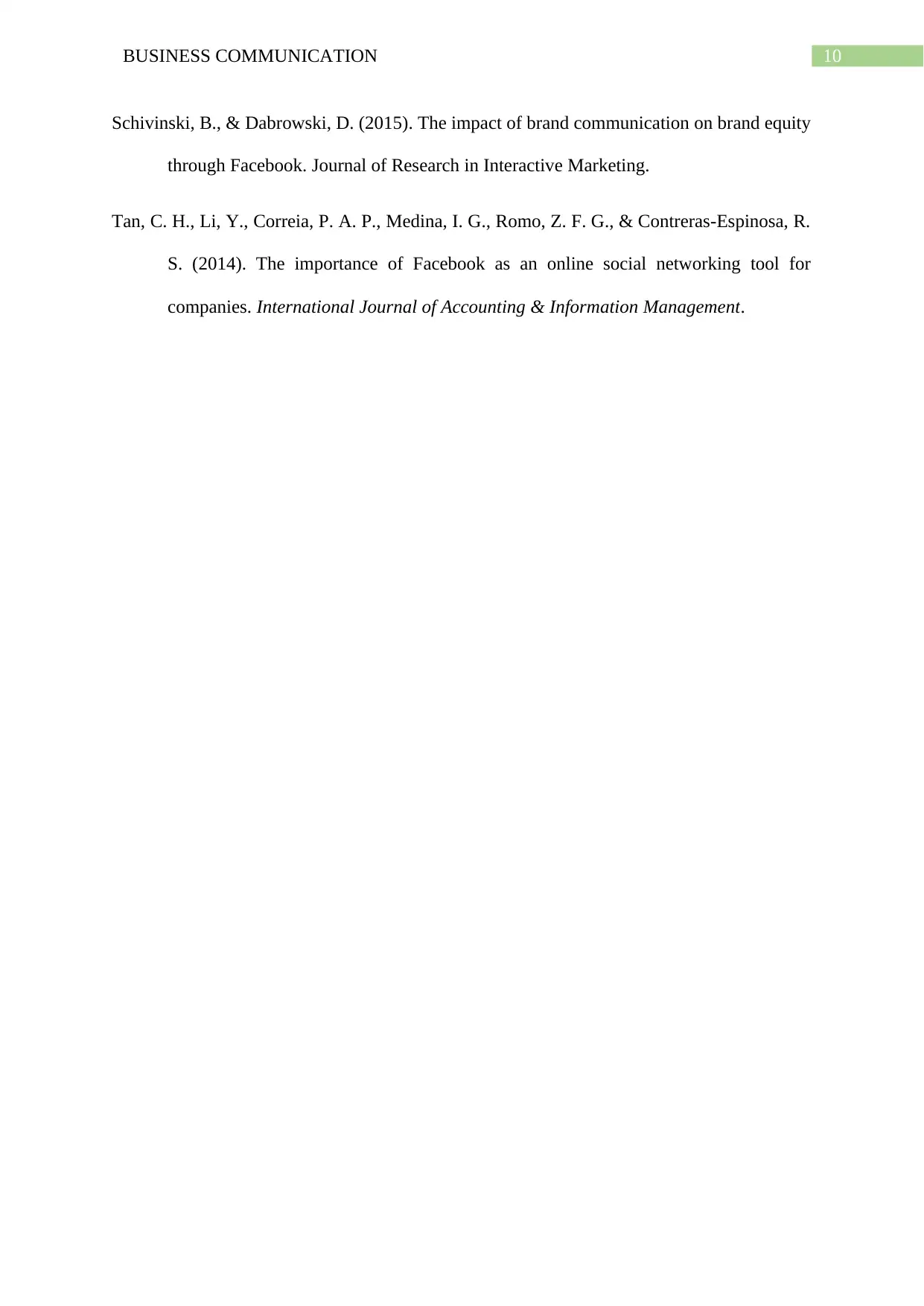
10BUSINESS COMMUNICATION
Schivinski, B., & Dabrowski, D. (2015). The impact of brand communication on brand equity
through Facebook. Journal of Research in Interactive Marketing.
Tan, C. H., Li, Y., Correia, P. A. P., Medina, I. G., Romo, Z. F. G., & Contreras-Espinosa, R.
S. (2014). The importance of Facebook as an online social networking tool for
companies. International Journal of Accounting & Information Management.
Schivinski, B., & Dabrowski, D. (2015). The impact of brand communication on brand equity
through Facebook. Journal of Research in Interactive Marketing.
Tan, C. H., Li, Y., Correia, P. A. P., Medina, I. G., Romo, Z. F. G., & Contreras-Espinosa, R.
S. (2014). The importance of Facebook as an online social networking tool for
companies. International Journal of Accounting & Information Management.
1 out of 11
Related Documents
Your All-in-One AI-Powered Toolkit for Academic Success.
+13062052269
info@desklib.com
Available 24*7 on WhatsApp / Email
![[object Object]](/_next/static/media/star-bottom.7253800d.svg)
Unlock your academic potential
Copyright © 2020–2025 A2Z Services. All Rights Reserved. Developed and managed by ZUCOL.





